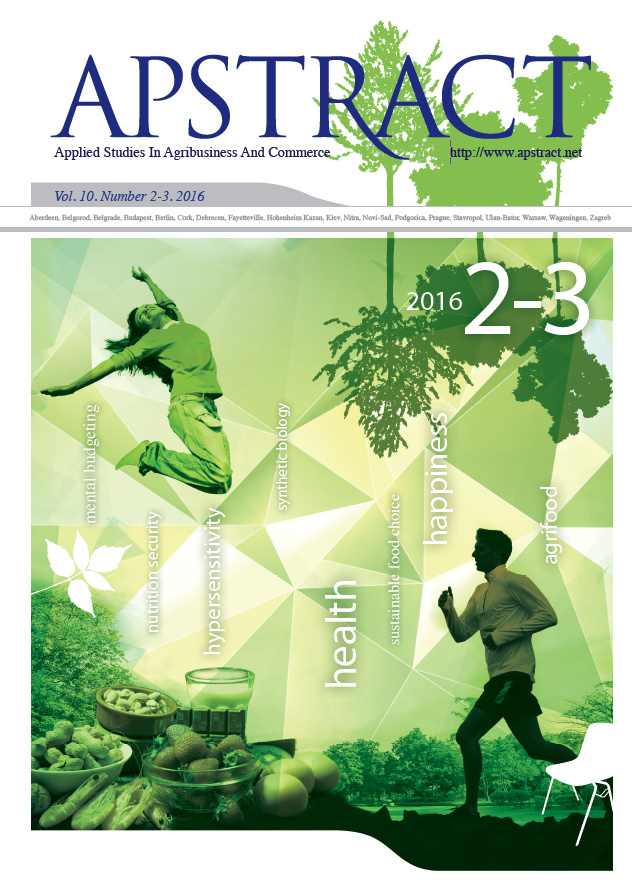Vol. 10 No. 2-3 (2016)
This issue of Apstract entitled Contributions to the understanding of issues with respect to behaviour,
food, happiness and health is a special one. It consists of contributions on topics and the way of research
that have been or are going on at the ECH group since Gerrit Antonides became the chair holder in 2002
and his retirement in October 2016. This issue can be regarded as a Festschrift for him.
This particular issue gives an impression of topics and kind of research in the 2002-2016 period. In this
way, it can be seen as pattern-card of the research of the group. There is great variety in the contributions
in many respects. There are contributions from past and present ECH colleagues. There are contributions
from other colleagues with whom Gerrit Antonides has co-operated for a long time.
There are contributions that give an impression of the kind of research work in BSc and MSc theses and
there are papers from past and present PhD students. Some papers are highly empirical, whereas others
are more of a theoretical nature. Some are rigorously empirical, others are essayistic publications that
give an overview of the state of art in a particular field of research. Many papers address issues from a
Behavourial Economics point of view. After all Gerrit Antonides is an internationally known specialist
is this field. He was editor of the Journal of Economic Psychology , and president and currently board
member of SABE. And, not the least, the contributions are very international in many respects.
The fifteen contributions are organised around four themes: Behaviour; Food; Allergy; and Happiness.
The Section Behaviour consists of six contributions. In the first article, Jack Knetsch provides an account
of Willingness To Pay (WTP) and Willingness To Accept (WTA) as two ways to measure the value of
(policy) options that lead to very different valuations. He proceeds to discuss that WTA is frequently
the more appropriate measure where WTP is routinely used. He identifies several fields in which the
differences between WTP and WTA are important and understudied.
The second article, by Manon de Groot and Fred van Raaij, deals with whether and how self-employed
entrepreneurs manage their finances. More specifically, they investigate the role of mental budgeting and
time orientation in healthy financial behaviour. They show that mental budgeting relates to worry about
one’s financial situation, but is not related to tax compliance.
The third article, by Natasha Stroeker, provides an account of the establishment and growing influence of
behavioural economics on Dutch government policy. In an interesting twist, she then suggests the use of
nudges to increase the integration of behavioural science knowledge in policy and describes how nudges
can be embedded in policy.
The fourth article, by Anouk Griffioen, Jannette van Beek, Simone Lindhout and Michel Handgraaf, gives an
overview of studies that investigate psychological distance as an important variable that affects perceptions,
intentions, and decision making in the environmental and health domains. They argue that differences
in the effect of psychological distance can be found between studies and constructs (e.g., perceptions vs.
intentions vs. behaviour) rather than between domains or between the psychological distance dimensions.
In addition, they discuss potential underlying mechanisms and identify topics for future research.
In the fifth article, Rein Haagsma and Pierre van Mouche analyse studies that investigate the endowment
effect using a standard choice paradigm (which they term the standard apple-Mars experiment) from
behavioural economics. They argue that, despite the claim in the literature that neoclassical theory cannot
explain the endowment effect, it is actually possible to use (a Marshallian application of) neoclassical
theory to explain these standard findings, in particular in cases where consumer indifference between
the options cannot be ruled out.
In the sixth article, Ynte van Dam and Hans van Trijp delve into the discrepancy between consumers’
attitudes and actual sustainable behaviour. They argue that for intrinsically motivated consumers, this gap is
fairly easily overcome and that the challenge lies with a-motivated individuals who need extrinsic motivation
to behave sustainably. Psychological construal level theory is used as an explanation for the attitude to
behaviour gap as a motivational conflict between high and low level of mental construal. They examine
four types of intervention strategies that can cater for extrinsic motivation for sustainable development.
In the Section Food there are four contributions. In her article, titled ‘Food and nutrition security as gendered
social practice’, Anke Niehof emphasizes the necessity of women empowerment to assure household food
security and good nutrition of children in developing countries. In her opinion that does not mean that
women are completely without power. However, improved access to critical resources would improve
their household food security and their children’s nutrition. Somewhat contradictory to this conclusion is
the observation that, except for south east Asia, the existing gender inequalities do not visibly result in a
gender gap in nutrition.
In ‘Women and microcredit in rural agrarian households of Uganda: Match or mismatch between lender
and borrower?’ Faith Namayengo , Johan van Ophem and Gerrit Antonides show that micro-finance can
play a major role in small enterprises in developing countries. They investigated the extent to which the
objectives and design of a specific micro-finance program (the BRAC program) match the expectations,
context and characteristics of female borrowers in a rural agrarian setting in Uganda. The clients are mainly
poor subsistence farmers who derive income from diverse farming and non-farm activities. The microcredit
is mainly used to pay school fees and investments in small non-farm businesses. The result of the
investigation was that the majority of borrowers was satisfied with the program and that the defaulting on
loans was quite low. Finally, we may conclude that the program contributes to wellbeing of the borrowers.
The research question in ‘The added value of sustainability motivations in understanding sustainable food
choices’ by Muriel Verain, Marleen Onwezen, Siet Sijtsema and Hans Dagevos is whether sustainability
motivations contribute to sustainable food choices. The results indicate that process or sustainability motives
are of added value above product motives in the understanding of consumer food choices. This paper
shows that the understanding of sustainable consumption can be improved by considering sustainability
motives apart from product motives. Further, it is important to take the sustainability dimension (e.g.,
fair trade versus environment) and the product category (e.g., meat versus fruit) into account. All in all
a most useful extension of the theory on consumer choices.
Lynn Frewer, David Coles, A.M. Dijkstra, S. Kuznesof, H. Kendall, and G. Kaptan discuss in their
paper ‘Synthetic biology applied in the agrifood sector: societal priorities and pitfalls’ several issues in
this area. Synthetic biology offers potential for innovation in the agrifood sector, although concerns have
been raised consumer rejection of applications will occur similar to that associated with the introduction
of genetically modified foods. Risk-benefit assessment should address socio-economic, as well as health
and environmental impacts. Ethical issues may be of particular relevance to the application synthetic
biology, and may also resonate with societal concerns. A case-by-case analysis of relevant issues may
be needed, and innovation must be driven by societal and consumer preferences as well as technological
possibilities. Research into consumer and societal priorities is required early in the innovation trajectory.
The Section Allergy starts with a review of the literature by Prescilla V. Jeurink, Athanasios Damiali, Harry
Wichers, and Huub F.J. Savelkoul in their contribution ‘The mutual influences of man-made pollutants
and allergic manifestations’. The review provides an overview of the different types of pollution, and the
health effects triggered by especially air pollution ranging from heart disease, pulmonary disease, cancer,
to fatal respiratory infections. In addition, the differences in how pollution-induced effects are affecting
different age-groups are discussed. Finally, the socio-economic causes and consequences (e.g. Quality of
Life and Years of Life Losses versus medical care cost) of these pollution-induced diseases are debated.
Jantine Voordouw and her co-authors - Gerrit Antonides, Margaret Fox, Inma Cerecedo, Javier Zamora,
Belen de la Hoz Caballer, Ewa Rokicka, Judith R. Cornelisse-Vermaat, Maciej Jewczak, Pawel Starosta,
Marek Kowalski, Monika Jędrzejczak-Czechowicz, Sonia Vázquez-Cortes, Sara Cano-Escudero, Bertine
M.J. Flokstra-De Blok, Anthony E.J. Dubois, Miranda Mugford, Lynn J. Frewer - assess ‘The direct and
indirect costs associated with food hypersensitivity in households: A study in the Netherlands, Poland, and
Spain’. A self-administered postal survey was conducted (n=1558) in three counties with a treatment and
a control group. It appears that the average total direct and indirect costs across all countries for families
with food hypersensitive family members are not higher than for households without food hypersensitive
members. However, the intangible costs for food hypersensitive individuals appear to be higher than for
individuals in the control group. The results do not support the hypothesis that all food allergies incur
high costs to the individual. However, being hypersensitive to foods may have a negative impact on quality
of life compared to people who are not food hypersensitive
The Section Happiness contains three papers. In their contribution ‘Transition economy and happiness:
the Czech Republic compared with The Netherlands in the 1990- 2004 period’ Johan van Ophem, Vit
Kohout and Wim Heijman analyse the relationship between income and happiness in the Czech Republic,
a (former) transition economy, and the Netherlands. They conclude that in the beginning of the nineties,
in the period after the great change of the economic system, the Czechs were less happy than the Dutch.
Further, they found that the happiness of the Czechs has been gradually increasing and is approaching the
level of happiness of the Dutch in more recent times, which can be related to a decreasing gap in income
and other relevant variables. In both countries happiness is positively affected by subjective health status,
perceived freedom of choice over life, being married or living together and satisfaction with one’s financial
situation and having trust in social institutions.
In ‘A note on the measurement of the relationship between happiness and GDP’ Wim Heijman, Johan
van Ophem and Job van Logtestijn compare the results of the measurement of the relationship between
happiness and GDP in the EU based upon ‘unweighted data’ with results based upon ‘weighted data’
which are supposed to present a more realistic picture of this relationship. It appears that the latter way
of measurement shows an even stronger relationship between GDP and happiness than the former.
Morris Altman addresses several issues on the diminishing returns relationship between happiness and
income in his contribution ‘Is there a kink in the happiness literature’. Appling some of the results of
prospect theory Altman argues that even if it were true that the marginal effect of income on happiness is
zero, a reduction in income would probably reduce the level of happiness, yielding a kink in the ‘happiness
curve’. Also, applying a target income approach to the happiness literature, one can argue that pursuing
higher target income, in itself, is a means of increasing life satisfaction.
In addition, applying insights from the capabilities approach, Altman argues that increasing income is a
means of purchasing the capabilities to increase individual levels of happiness through the production of
public goods, such as health care and education.
Full Issue
##issue.tableOfContents##
Articles
-
Some uses, underuses, and misuses of the findings of disparities between people’s valuations of gains and losses
7-13Views:314The well-known behavioural finding that losses have a greater impact on people’s well-being than gains, has important implications for the study of individual and collective choices, as well as the ways in which analyses are carried out -- many more than have yet been seriously considered. It also has many for analysts’ use of such tools as price elasticities, discount rates, value of statistical lives, risk analysis, and the like. A greater recognition of the behavioral findings would likely lead to reductions of the biases in many present analyses.
pdf171 -
The role of mental budgeting in healthy financial behavior: a survey among self-employed entrepreneurs
15-25Views:538Self-employed entrepreneurs (without personnel) manage their business and household finances at the same time. Both domains tend to interact with each other. In this study, it is studied whether and how self-employed entrepreneurs manage their finances. More specifically, the role of mental budgeting and time orientation in healthy financial behavior is studied. Mental budgeting is a way to manage expenses. It entails setting budgets, making reservations on budgets, compensating after too much spending on a budget, and non-fungibility (treating money as earmarked and categorized). It can be expected that self-employed entrepreneurs using mental budgeting strategies behave in a more healthy financial manner. Survey data were collected among self-employed people without personnel in The Netherlands. The survey contained, among others, questions about the company, time orientation, financial management, tax attitude, reported tax compliance, and concern or worry about the future. Questions were factor analyzed using principal component analyses. The resulting scales were used for further analyses. Regression analyses were performed to predict concern or worry about finances, financially restricting to and exceeding budgets, and reporting tax compliance. In this paper, two components of time orientation are distinguished: awareness of consequences and carelessness about the future. From these components, four orientation types of self-employed people were obtained. The orientation type focusing on long-term consequences shows more healthy financial behavior, whereas the orientation type focusing on the present and less on consequences shows less healthy financial behavior. Responsible and healthy financial behavior of self-employed entrepreneurs is related to focusing on long-term consequences, using mental budgeting, and keeping one’s budgets. Aspects of mental budgeting are predicting worry about business finances. Differential effects of mental budgeting were found on restricting one’s budgets, and exceeding budgets, respectively. Of two measures of future circumstances (work disability, pension), only pension measures were predicting worrying about finances. Mental budgeting was not related to tax compliance, except for fungibility. Past tax behavior is predictive of other (past) tax behaviors. Fiscal history measures prove to be correlated with present measures.
pdf329 -
An overview of behavioral economics in Dutch policy making. the next step: how to nudge policy makers
27-31Views:413This article describes the beginning of the influence of behavioral economics on the Dutch government. This started in the period that the UK started with its Behavioral Insights Team (BIT UK). The article presents explanation of the concept “nudging” and the way this is integrated in Dutch policy. Also leading publications and examples of how behavioral economics is used in policy making are presented. The advice of the government in 2014 on how to ensure a structural integration of behavioral science knowledge in policy is part of the next step. The next step contains two main parts: 1. How to nudge policy makers and 2. Embedding nudges in policy making on four aspects: positioning, projects, performance and professionality.
pdf258 -
Distance makes the mind grow broader: an overview of psychological distance studies in the environmental and health domains
33-46Views:1529Environmental and health issues are two of the most pressing issues society faces today. People often view both environmental and health issues as psychologically distant: they believe that the problems will occur in the future, to other people, in other places and that the exact outcomes are uncertain. This paper provides an overview of studies that have investigated how the different psychological distance dimensions (viz., temporal, spatial, social and hypothetical) influence perceptions, intentions, and decision making in the environmental and health domains. This overview suggests that psychological distance indeed matters in both domains. There are indications that threat perceptions are mostly heightened when communicated or perceived as being psychologically close. However, the studies also show that a mere increase in perceived threat does not necessarily alter intentions or behavior. Moreover, with regard to the effects of psychological distance, there are neither clear differences between the environmental and the health domain nor between the four psychological distance dimensions. We discuss possible moderators that may explain the range of findings. Finally, we conclude with discussing the current stance of the literature and discuss specific research topics that are yet to be studied. As environmental and health behavior involve more than just one decision or one behavior, we suggest, for example, that future studies should investigate how psychological distance influences not only the target behavior, but related behavior as well.
pdf933 -
On the endowment effect in `apple-mars’ experiments
47-50Views:324In this article we take a close look at a specific type of behavioural experiment that Antonides conducted to study the endowment effect. We argue that if such experiments ignore to test for the presence of persons in the sample who are indifferent between alternatives, the identification procedure for establishing an endowment effect is fallible.
pdf119 -
Interventions to encourage sustainable consumption
51-58Views:704Sustainable consumption is hampered by a discrepancy between consumers’ attitudes and their actual behaviour in the market place. Psychological construal level theory provides an explanation for the attitude to behaviour gap as a motivational conflict between high and low level of mental construal. Based on self-determination theory it is argued that this motivational conflict presupposes extrinsic motivation for sustainable behaviour. Based on self-regulatory styles, the present paper identifies and illustrates four types of intervention strategies that can cater for extrinsic motivation for sustainable development among light users. The underlying mechanisms of these interventions suggest that the transition from external to internal regulation is catalysed by social feedback.
pdf397 -
Food and nutrition security as gendered social practice
59-66Views:467In many parts of the world, the food security of households and the nutrition security of individual household members, in particular that of children, are still at risk, in spite of the progress made in combatting hunger at the global level. The prevailing opinion among scientists and development practioners alike is that women’s empowerment is the key to household food security and good nutrition of children. Similarly, it is thought that gender inequalities manifest themselves in dietary discrimination of women resulting in their lesser access to sufficient and nutritious food. To investigate the credibility of these ‘common truths’, empirical evidence on women’s roles in the social practices that aim at realizing household food security and good family nutrition was reviewed. It can be concluded that women definitely yield and wield power through their involvement in and responsibility for these practices, but that – at the same time – enhancing women’s capabilities by improved access to critical resources would benefit their household’s food security and their children’s nutrition. Furthermore, except for the region of South Asia, gender inequalities do not visibly result in a gender gap in nutrition, although women’s specific dietary needs in relation to pregnancy and motherhood are not always recognized.
pdf189 -
The added value of sustainability motivations in understanding sustainable food choices
67-76Views:1036Understanding consumer food choices is crucial to stimulate sustainable food consumption. Food choice motives are shown to be relevant in understanding consumer food choices. However, there is a focus on product motives, such as price and taste, whereas process motives (i.e. environmental welfare) are understudied. The current study aims to add to the existing literature by investigating the added value of sustainable process motives (environmental welfare, animal welfare and social justice) above product motives. Two on-line surveys of representative Dutch samples tested whether process motives increase the explained variance of sustainable consumption. The results indicate that sustainable process motives are of added value above product motives in the understanding of consumer food choices. In addition, product categories differ in the sustainable process motives that are most useful in explaining sustainable purchases in that category (Study 1), and different types of sustainable products (organic versus fair trade) differ in the sustainable process motives that are most useful in explaining these purchases (Study 2). In conclusion, this paper shows that understanding of sustainable consumption can be improved by considering sustainable process motives above product motives. Thereby, it is important to take the sustainability dimension (e.g., social justice versus environmental welfare) and the product category (e.g., meat versus fruit) into account.
pdf390 -
Women and microcredit in rural agrarian households of Uganda: Match or mismatch between lender and borrower?
77-88Views:560The alignment of microfinance programs with the context and expectations of the recipients is critical for ensuring clients’ satisfaction and desired program outcomes. This study sought to investigate the extent to which the objectives and design of the BRAC microfinance program match the expectations, context and characteristics of female borrowers in a rural agrarian setting in Uganda. Quantitative and qualitative methods were used to obtain socio-demographic, personality and microenterprise (ME) characteristics of existing borrowers, incoming borrowers and non-borrowers and to obtain information about the microcredit program. We found that BRAC uses a modified Grameen group-lending model to provide small, high-interest rate production loans and follows a rigorous loan processing and recovery procedure. BRAC clients are mainly poor subsistence farmers who derive income from diverse farming and non-farm activities. The major objective to borrow is to meet lump-sum monetary needs usually for school fees and for investment in informal small non-farm businesses. Many borrowers use diverse sources of funds to meet repayment obligations. Defaulting on loans is quite low. The stress caused by weekly loan repayment and resolution of lump-sum cash needs were identified as reasons for women to stop borrowing. The limited loan amounts, the diversions of loans to non-production activities, the stages of the businesses and the weekly recovery program without a grace period may limit the contribution of these loans to ME expansion and increase in income.
pdf242 -
Synthetic biology applied in the agrifood sector: Societal priorities and pitfalls
89-95Views:503Synthetic biology offers potential for innovation in the agrifood sector, although concerns have been raised consumer rejection of applications will occur similar to that associated with the introduction of genetically modified foods. Risk-benefit assessment should address socio-economic, as well as health and environmental impacts. Ethical issues may be of particular relevance to the application synthetic biology, and may also resonate with societal concerns. A case-by-case analysis of relevant issues may be needed, and innovation must be driven by societal and consumer preferences as well as technological possibilities. Research into consumer and societal priorities is required early in the innovation trajectory.
pdf150 -
The mutual influences of man-made pollutants and allergic manifestations
97-105Views:457The United Nations have projected the world population to reach 9.6 billion by 2050 and that, by then, over 50% of the world population will be living in urban areas. This continuing population growth and accompanying urbanization lead to serious concerns about clean water and food for all, but also about climate change and pollution. Soil and water pollution are directly affecting the crops grown for consumption, and air pollution is affecting our mucosal barriers in the respiratory and gastro-intestinal tract on a daily basis. This review provides an overview of the different types of pollution, and the health effects triggered by especially air pollution ranging from heart disease, pulmonary disease, cancer, to fatal respiratory infections. In addition, the differences in how pollution-induced effects are affecting different age-groups are discussed. Finally, the socio-economic causes and consequences (e.g. Quality of Life and Years of Life Losses versus medical care cost) of these pollution-induced diseases are debated.
pdf116 -
The direct and indirect costs associated with food hypersensitivity in households: A study in the Netherlands, Poland, and Spain
107-117Views:391Background: Recent studies show that food hypersensitivity, such as food allergy or food intolerance, has the potential to affect direct, indirect and intangible economic costs experienced by individuals and their families. This research assesses the direct and indirect economic costs of food hypersensitivity at the household level in the Netherlands, Poland, and Spain.
Methods: A self-administered postal survey was conducted (n=1558). Respondents with food hypersensitivity were clinically diagnosed cases recruited through clinical centres in Poland and Spain. In the Netherlands, food hypersensitivity cases were recruited through hospitals, patient organisations and advertisements. The controls formed the baseline sample and were obtained from households in which none of the members had food hypersensitivity. The monetary value of indirect costs, forgone time, was calculated using the opportunity cost method. The indirect and direct costs were expressed in purchasing power parity. Analysis of co-variance on the cost items was used to test the within-country differences between respondents with food hypersensitivity and respondents without food hypersensitivity, as well as across the three countries.
Results: The average total direct and indirect costs across all countries for families with food hypersensitive family members are not higher than for households without food hypersensitive members. However, the intangible costs for food hypersensitive individuals appear to be higher than for individuals in the control group.
Conclusions: These results do not support the hypothesis that all food allergies incur high costs to the individual. However, being hypersensitive to foods may have a negative impact on quality of life compared to people who are not food hypersensitive.pdf175 -
Transition economy and happiness the Czech Republic compared with the Netherlands in the 1990- 2004 period
119-126Views:338The paper deals with the subject Transition economy and happiness – a case study of the Czech Republic in a comparison with The Netherlands in the 1990- 2004 period. The paper addresses the following two questions: 1. How has the level of happiness changed since 1990 in the Czech Republic and in The Netherlands? 2. Are there differences with respect to variables that explain differences in happiness between both countries. It appears that. at the beginning of the 1990s of the last century, the Czechs were less happy than the Dutch and, that, people in the Czech Republic were less happy in 1999 than they were in 2004. Furthermore, Happiness in the Czech Republic is approaching the level of happiness in The Netherlands. In both countries happiness is positively affected by subjective health status, perceived freedom of choice over life, being married or living together and satisfaction with one’s financial situation and having trust in social institutions. But there are differences with respect to the impact of age, education and religion .
pdf128 -
A note on the measurement of the relationship between happiness and GDP
127-129Views:662This research note compares the results of the measurement of the relationship between happiness and GDP in the EU based upon unweighted data with the results based upon weighted data. The data are weighted in order to correct for the different sizes of the populations in the EU countries concerned. The result of the weighing is an even stronger relationship between happiness and GDP per capita than in the case with unweighted data.
pdf236 -
Is there a kink in the happiness literature?
131-139Views:689One of the early key empirical findings of the happiness literature is that at higher levels of per capita real income there appears to be diminishing returns to income at least with regards to marginal changes in ‘happiness’ measured by various survey instruments. Although these results have been recently challenged, these earlier findings and the results of many contemporary studies suggest that an inelastic relationship exists between real per capita income and happiness after a relatively low threshold of per capita income is reached. Appling some of the results of prospect theory I argue that even if it were true that the marginal effect of income on happiness is zero, a reduction in income would probably reduce the level of happiness, yielding a kink in the ‘happiness curve’. Also, applying a target income approach to the happiness literature, one can argue that pursuing higher target income, in itself, is a means of increasing life satisfaction. These two theoretical instruments yield results consistent with some of the most recent empirical finding based on Gallup Poll Survey data. In addition, applying insights from the capabilities approach, I argue, that increasing income is a means of purchasing the capabilities to increase individual levels of happiness through the production of public goods, such as health care and education. A given marginal increase in income need not generate any increase in happiness if this income increase is highly unequally distributed in a population or is not used to purchase goods and services that contribute to increases in the level of happiness.
pdf319






